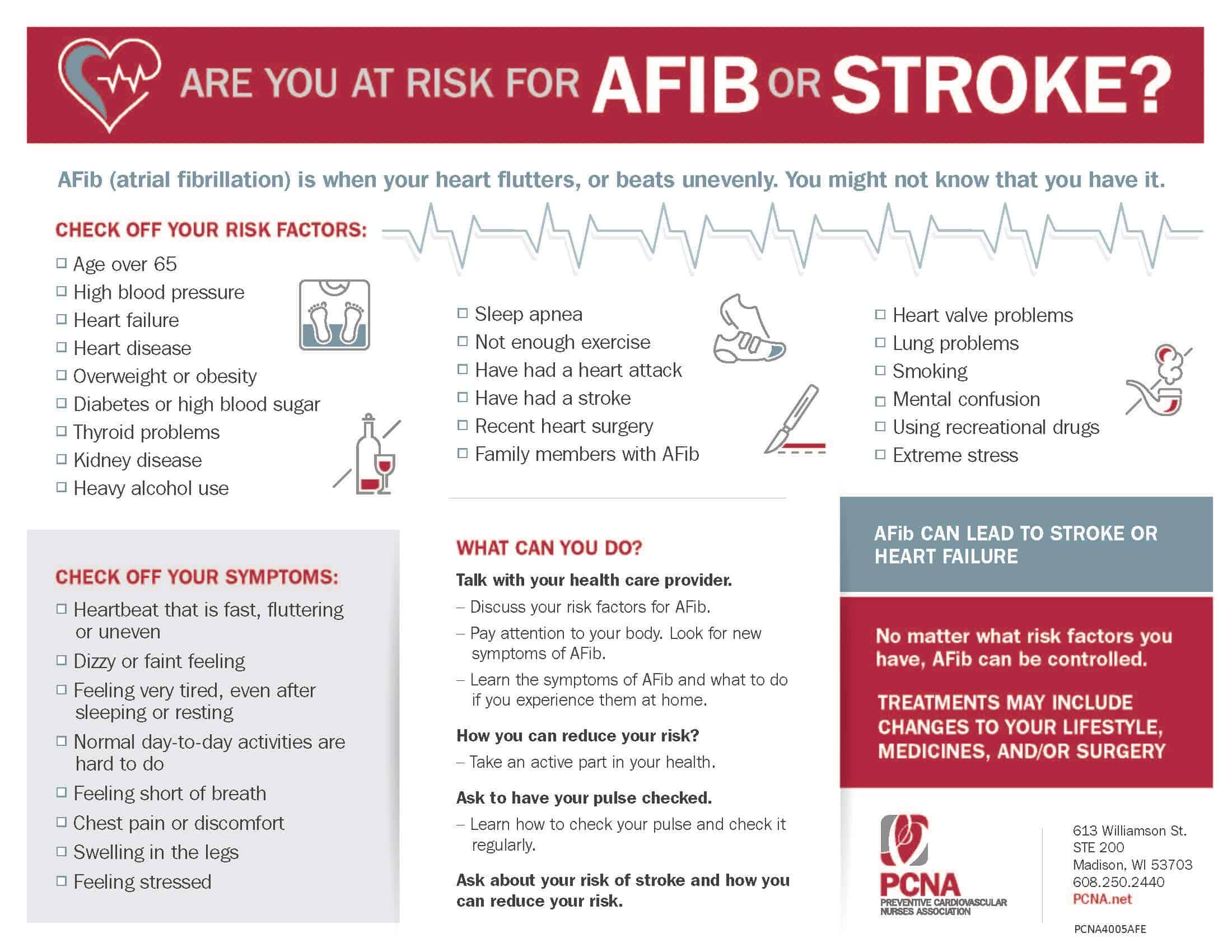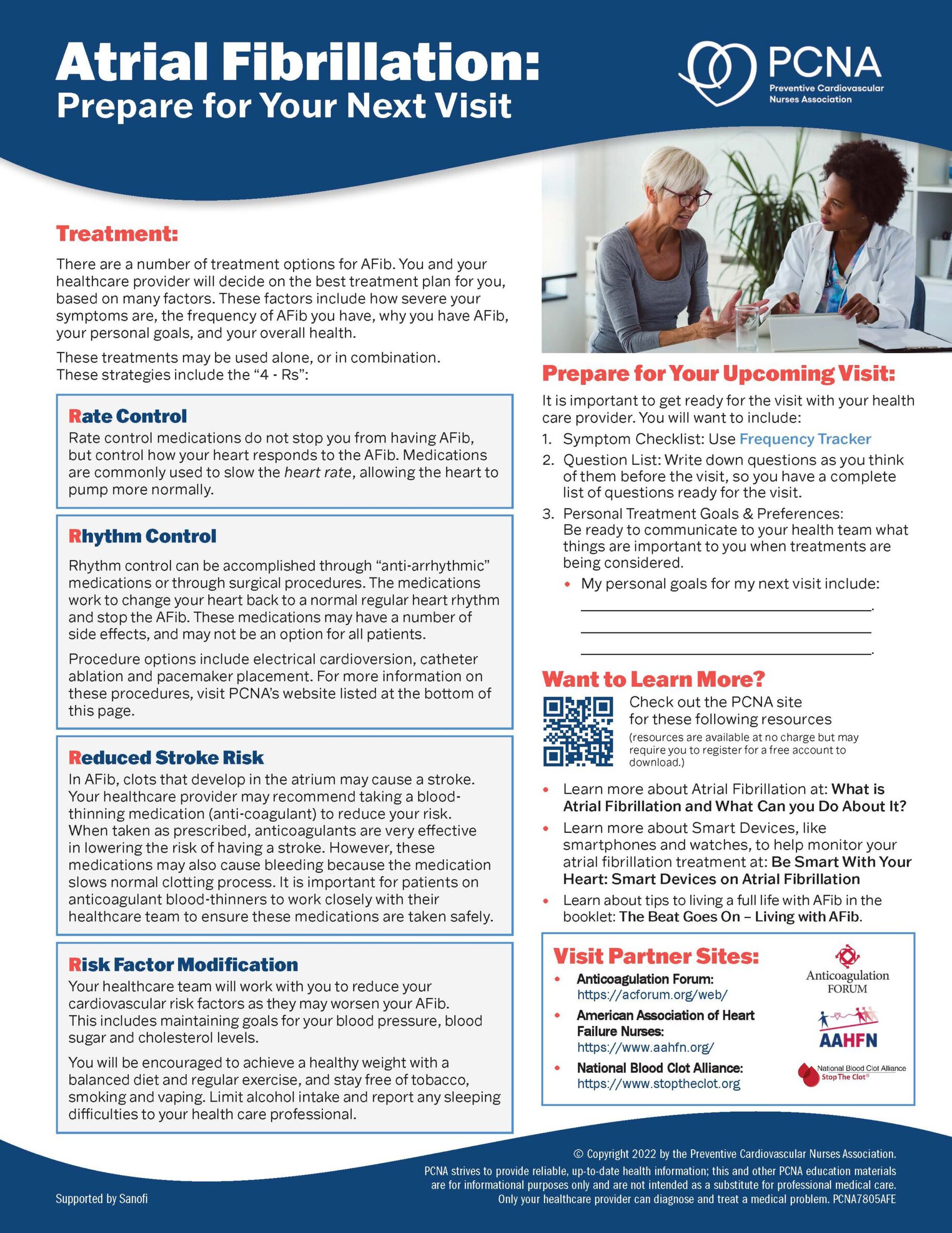The interrelationship of sleep apnea and atrial fibrillation (AFib) should be front of mind for clinicians. Learn keys to guideline-directed therapy including diagnosis, risk scores, the importance of anticoagulation, rate- and rhythm-controlling medications, and pacemakers, from guest Lisa Maher, DNP, ARNP, FNP-BC, FPCNA, Unitypoint Health Allen Hospital Cardiovascular Center.
Episode Resources
Welcome to Heart to Heart Nurses, brought to you by the Preventive Cardiovascular Nurses Association. PCNA’s mission is to promote nurses as leaders in cardiovascular disease prevention and management.
Geralyn Warfield (host): Today we’re in conversation with Nurse Practitioner, Lisa Maher. Lisa, why don’t you go ahead and introduce yourself?
Lisa Maher (guest): Hi, my name is Lisa Maher. I’m a Nurse Practitioner for the Unitypoint Health Allen Hospital Cardiovascular Center that’s located in Waterloo, Iowa. I’ve been in practice there almost 14 years now as a nurse practitioner. I focus on treating patients with any general cardiac disorders. So, that can be anything from chest pain to coronary disease, to AFib, to heart failure.
And then I also specialize in sleep apnea and run our sleep apnea clinic, in which I see patients suffering from any sleep disorder, specifically obstructive [00:01:00] sleep apnea or complex sleep apnea. I see them about one to two days a week.
Geralyn Warfield (host): So, it sounds like we could have a number of different conversations based on your expertise. And we are so glad that you’ve decided to join us today. I think our focus today should be more on AFib, and we will weave in some of those other things. And so, Lisa, if you could tell us initially, can you describe the relationship between sleep apnea and AFib?
Lisa Maher (guest): Yeah. So, this is something that not a lot of times is brought into the forefront when we talk about AFib. It’s, sleep apnea is, unfortunately, something a lot of times will get pushed to the back of the table, or the back of the discussion, because we’re more worried at the time about treating the AFib, because usually, that’s what patients feel the most symptomatic with as their symptoms related to AFib.
So, the relationship when, when the atria are sensing that there is some type of stress within the heart, when we look at things, a lot of times we’re talking about rate control and [00:02:00] changing the rhythm whereas sometimes we miss the underlying condition—the cause of the AFib. With the correlation between AFib and, and sleep apnea, we’re looking that the heart can get stressed at night, especially when it’s not receiving appropriate oxygen. And when it’s not receiving appropriate oxygen at night, one of the ways the body responds is that the heart can freak out and we can see an abnormal rhythm. So, a lot of times that’s when we see AFib initially occurring at night.
So, in our patients with AFib that, maybe, they’re not symptomatic, or maybe it’s proximal AFib where they’re in and out of rhythm. A lot of times when we have them wear a monitor for 24 or 48 hours or two weeks, what we see is they’re having more incidents at night. And when they’re having more incidents at night of that, AFib, then we should automatically look to rule out any underlying sleep apnea.
So, [00:03:00] at that point, we’d want to talk about the importance of getting a sleep study in, and just seeing if there is any oxygen desaturation, or if there’s truly the underlying condition of sleep apnea. Once we have that diagnosis, it is so important to treat. When we talked to general cardiology and then we talked to EP [electrophysiology], once they reached that, that electrophysiology standpoint and we’re specifically looking at treating, EP, one of the things they always fall back onto is treatment of the AFib. Because then we’re looking at the long-term success of medication therapy and patients who have their sleep apnea treated and use certain type of medications, such as antiarrhythmics, or go for a procedure such as ablations or cardioversions, have better success rates if their sleep apnea is treated appropriate.
Geralyn Warfield (host): Thank you very much for including that idea of sleep apnea as we’re in the clinical setting and working with patients. So, as we’re talking about that trajectory from diagnosis through [00:04:00] treatment, if you wouldn’t mind spending a little bit of time talking about how important anticoagulation is in that whole process?
Lisa Maher (guest): Yeah. This is something that I talk with my patients when they have AFib extensively. And a lot of times we’re going to want to look at, I talk about AFib itself is not life-threatening, it doesn’t hurt you, it doesn’t hurt the heart. But with that, there’s always that, that hangover of stroke, the risk of stroke, which we know can be, can be fatal or it can resolve itself.
But most of the time we don’t know how people are going to respond to a stroke until they have that. And then we’re stuck dealing with those consequences. So, when it comes to treatment in AFib and anticoagulation, we look at a score and we use a score called the CHA₂DS₂-VASc score.
That helps us to re-stratify any underlying risk that would increase their risk for stroke. When we look at a [00:05:00] CHA₂DS₂-VASc score, we look at their underlying—so CHA₂DS₂-VASc stands for congestive heart failure, hypertension, their age, whether they’re diabetic, the sex (so, male or female), and then whether they have any underlying cardiovascular or vascular component to that. If they have any one of those conditions, we rate this in the scale; the higher or the more number of conditions or the, the higher the points, the greater increase their risk for stroke is, the greater likelihood we would start them on anticoagulation.
When we start anticoagulation too, one thing we always look at is also their bleeding risk, because if somebody just had a major GI bleed, or has an underlying condition that, that predisposes them to that, it might not always be the safest.
The other thing I always look at when starting anticoagulation is going to be a patient’s age. So, with that, [00:06:00] sometimes you have these 90-plus-year-old patients. Sometimes they are completely independent at home and they’re not a fall risk, but sometimes you have those patients, too: fall risk. They know, that that takes into account whether you would want to consider anticoagulation—or not—with them.
When talking about anticoagulation, too, something we always look at is going to be the guidelines. So, when talking about the standard warfarin or Coumadin versus the NOACs or DOACs that are out there. One thing I stress when I’m talking to patients is the risk of bleeding versus the risk of efficacy with the medications. One reason, in particular, my patients tend to like a NOAC or DOAC would be the ease of taking it; it would be once daily or twice daily, depending on which medication.
And with [00:07:00] that, once they take it within a certain period of time, usually up to six hours, they are going to be therapeutic, meaning their risk for stroke is cut down. When we look at warfarin or Coumadin, we sometimes could take days to get that regulated, we could take weeks to get that regulated depending on the dosage and how their INR level responds, so that deals with lab work and the routine lab work.
In two specific patient populations, we would not want to start a NOAC or a DOAC. Those would be the patients with a mechanical valve. So, any time there is any mechanical valve, the NOAC or DOACs (the new anticoagulants) are not indicated for those patients for treatment. So they would have to stay on Coumadin or warfarin.
And then the other would be with mitral stenosis patients. So, if, if you have a new AFib [00:08:00] patient, you don’t know their underlying valve history and you would get an echo or an ultrasound of the heart. You would want to look to see if there’s any underlying evidence of mitral stenosis. If there is moderate or severe mitral stenosis, Coumadin or warfarin would be indicated; as would a NOAC or DOAC would not be indicated for those patients.
Geralyn Warfield (host): Great. I had a question the about the anticoagulants themselves. I know that some come with a reversal agent, others do not. So, I suspect that’s a consideration in practice as well. And I also was thinking about patients who are slated for, let’s say, a dental procedure. So could you talk just a little bit about what being on an anticoagulant of any kind has to do with those two things?
Lisa Maher (guest): Yeah, you bet. So, when we’re talking about anticoagulation and reversing, rarely do we actually fully reverse the anticoagulant, or give them a medication that would either get that completely out of their system or bring their level down, [00:09:00] unless it was a serious event, like a car accident. When we’re talking about stopping it for an elective procedure, usually there are guidelines set up as far as how long, you know, that can stay in the system. And, sometimes it is surgeon-dependent. And, sometimes it depends on the patient’s underlying condition, too, which, in which they were started for the anticoagulation.
With warfarin or Coumadin, it does take longer to get out of the system. So, usually, they are off that medication longer than standard NOAC or DOAC would be 24 to 48 hours depending on the procedure.
Geralyn Warfield (host): Great. So, there are a lot of considerations when it comes to treating AFib and what treatment is best for each patient.
Lisa Maher (guest): Yes. Correct.
Geralyn Warfield (host): We’re here with Lisa Maher and we’ll be back in just a moment to talk more about AFib.
Geralyn Warfield (host): We’re back with Lisa Maher and we’re talking about AFib and some of the [00:10:00] considerations for clinical practice. So, we’ve spoken already about identification and treatments. And I have a question for you about rate-controlling medications. Can you talk a little bit about how beta-blockers, calcium channel blockers, and other medications are used, and anything that as a clinician we might want to watch out for?
Lisa Maher (guest): You bet. When we’re talking about AFib, when we are talking about controlling the heart rate, what we will do is we will look at certain classes of medications that are helpful to control the heart rates. And, obviously, that are safe for the patient. We look at two classes. Most often those are going to be your beta blockers and your calcium channel blockers, purely for rate control rather than rhythm control.
So, sometimes people get confused when we talk about all of this. So, rate control means that we’re purely just controlling the heart rate. Usually, we want to get that heart rate less than 100 beats per minute, so [00:11:00] that the patient is not so symptomatic. A lot of the times when you hear patients symptomatic with AFib, it’s purely because the heart rate takes off and races. So, if we can control that heart rate, we can keep their symptoms under better control. And that allows us time too, to figure out what we’re going to do or how we’re going to treat the medication.
When we’re talking more about rhythm control, we’re talking about a group of medication called antiarrhythmics. Those are specifically started to change the rhythm from AFib to a normal sinus rhythm. Those are medications that are not always started in an outpatient setting. So those are something that I advise you talk with your general cardiologist; and usually, at that point, it referred onto either even an electrophysiologist at that point to start these medications.
Again, some need to be monitored very closely. And the patient needs to be admitted to the hospital, in order to watch, because even though these medications are safe, [00:12:00] if started as an outpatient, what we want to monitor for is that they wouldn’t have an adverse effect and have that medication be pro-arrhythmic, or actually caused them a life-threatening rhythm.
Geralyn Warfield (host): So, we’ve talked a little bit about medications and how to control AFib using anticoagulants, how to do rate and rhythm kinds of control. But sometimes that doesn’t quite get the job done. So, I’m hoping you could spend a few minutes talking to us about the potential for pacemaker therapy with AFib and how that fits into the complement of treatment that we might have.
Lisa Maher (guest): Yeah. So, with, with AFib, a lot of times people automatically think of AFib and they think of any rhythm and they automatically think of a pacemaker. That’s not always the case. So, when we talk about AFib, usually—purely because of the nature of AFib and the way it affects the SA node over time, naturally, the heart rate can, can slow down and that’s when we would use a pacemaker. [00:13:00] So sometimes the confusion is that if patients get a pacemaker, [it] is going to cure or fix their AFib when it is not going to do that. A pacemaker is purely used to help with a slow heart rate to improve a slow heart rate.
And at that point, if the patient is still in AFib and, a lot of times, having a fast heart rate, we can add those medications such as the beta-blockers, such as the calcium channel blockers, to bring down their heart rate without worrying that we’re going to bottom, or cause the patient to get dizzy and pass out.
So, pacemaker is used sometimes in conjunction, where we want to get the heart rate slow, but we can’t get it too slow, but we still need medication to help.
Geralyn Warfield (host): So, it sounds like in all of these different types of therapies, using shared decision-making is a very important aspect of this because different medications, different treatments, are going to affect different patients in ways that maybe are unexpected, or [00:14:00] maybe we know what to expect, and maybe isn’t going to fit into their quality of life.
Are there any key takeaways for discussions with patients about these particular methods for treatment that you use in your clinical practice that we could apply in ours?
Lisa Maher (guest): I think it’s just an honest discussion with each patient that comes in because each patient is not going to have the same circumstances surrounding the AFib, or in their other health conditions, or their social aspects of life.
So, I think it’s just having an honest, honest conversation about AFib and saying, “Look, these are our options. This is one option. Here are the risks or benefits associated with this. Here’s another option. And here are the risks and benefits associated with this. Let’s figure out what will work best for you.”
So again, a lot of times, I, there is a stepwise approach to treating AFib, but you have to look at the patients and you have to involve and use that shared decision-making, not only with the [00:15:00] patient, but also family members or caregivers who are also involved in their care, because AFib is usually not something it’s just a one-time and done thing.
AFib is more of a nuisance, and it continues to come back. It all depends, too, on how symptomatic the patient is. If a patient is really symptomatic, we’re going to want to do things quicker and more effectively to help them feel better. If they’re not as symptomatic, we definitely have more time, as long as they’re anticoagulated.
Geralyn Warfield (host): Great, great information. I also was hoping you could touch on AFib and cryptogenic stroke because of that interconnectedness there.
Lisa Maher (guest): Yeah. This is also another really interesting topic that I do think gets missed. So, if a patient comes in with a TIA or a stroke, first thing we want to do is try to find a cause.
We want to, obviously, treat the symptoms too, but we like to look for an underlying cause. [00:16:00] Usually, that will involve neurology workup. If neurology workup is okay, if the imaging of the head—so, usually, a CAT scan and/or MRI of the head and neck, if there is no underlying clot or any vascular disease, as far as a carotid disease—what we want to do then is look from a cardiac standpoint or a heart standpoint.
Usually, at that time, that will involve either a consult while in the hospital to cardiology or an outpatient consult, if the patient is well enough to go home. At that point, we’re going to want to look at an ultrasound or an echo to ensure that there is no underlying PFO, or whole or abnormal communication between the right and left sides of the heart.
If there is a PFO, we want to treat or look at treating that to see if that is the cause. If that is negative, the next thing we want to do is work on some type of monitoring. So, what [00:17:00] people, a lot of times don’t understand is with AFib, sometimes AFib comes and goes so briefly, it’s there long enough to cause the stroke, but by the time the patient seeks attention, they’re back in a regular rhythm.
So, ideally, we would do some type of monitoring. Usually, we will start with a 24- or 48-hour monitor just because that’s very easy to hook up the patient and send them home. If that comes back negative, meaning that the patient has stayed in sinus or there is no underlying atrial fibrillation, at that point we want to do longer monitoring. Now, and this is insurance-dependent, whether we would have to proceed with a 30-day monitor or whether we would look at what’s called a loop recorder—an implantable device—to monitor for any underlying rhythm. A loop recorder can be left in for up to three years. And it’s a very helpful tool that, if a patient is not symptomatic with a AFib, we can track and find AFib.
So, [00:18:00] cryptogenic stroke basically means that there is not a cause found. So, at that point, we presume it’s underlying AFib as the cause; we just have to catch it, basically.
Geralyn Warfield (host): So, when you use the loop recorder, how often is your office looking at that information? Are there trigger points that are causing your team to take notice?
Lisa Maher (guest): Yes. So, with a loop recorder, initially, after it’s put in, we always like at least a seven-to-10-day check and that’s to check the actual insertion site to make sure it’s healed okay. But then also to make sure it’s reading appropriately and capturing appropriately. Beyond that, the patient has a home monitor that they go home with. The home monitor consists of the actual monitoring piece of it, but it also has a little trigger button. So, if they would ever feel something, or if they would start to exhibit symptoms of a stroke, spouse or significant other or caregiver or family, if, if they’re with it could also press the button for them. And we could [00:19:00] ‘trigger’ that event.
If an event is triggered, that immediately uploads to my office system. And, at that point, we can see is there a correlation. Is it truly an underlying rhythm or is it something that maybe the patient felt like the heart was racing or going fast, and it could have been an underlying anxiety or something else?
Beyond that, if they don’t trigger any events, it is checked at least monthly. And then, usually, that is a remote check unless the patient prefers to come into the office. But the nice things about these loop recorders is they’re with the patient, they’re very small, you don’t have a large scar, and they go anywhere. So, if you have a patient that travels even overseas or, you know, travels to see grandkids or something that way, the device continues to monitor and uploads that information. They can always take their special remote with them, and it can trigger [00:20:00] an event, or trigger an event that we would see from anywhere. So that’s the really nice thing about it.
Geralyn Warfield (host): Well, it sounds like there are plenty of opportunities for learning more about AFib and how to apply the great information that you’ve shared with us today in practice. Is there anything else that I have neglected to ask that you would like to share with our audience?
Lisa Maher (guest): No, you’ve done a great job of asking. I just, I think it’s important for people to pay attention and if they feel something different, whether that be a sensation in their heart, a palpitation, a pounding sensation of fast heartbeat, to just talk to your doctor or your provider about it, because if we can catch it and we can prevent a stroke, that’s definitely what we want.
Geralyn Warfield (host): Most definitely. Well, we’ve been in conversation with Lisa Maher and our audience cannot thank you enough for sharing such great information about AFib in this podcast.
I’m your host Geralyn Warfield, and we will see you next time. [00:21:00]
Thank you for listening to Heart to Heart Nurses. We invite you to visit pcna.net for clinical resources, continuing education, and much more.
Topics
- Atrial Fibrillation
Published on
September 6, 2022
Listen on:

DNP, ARNP, FNP-BC, FPCNA
Related Resources









